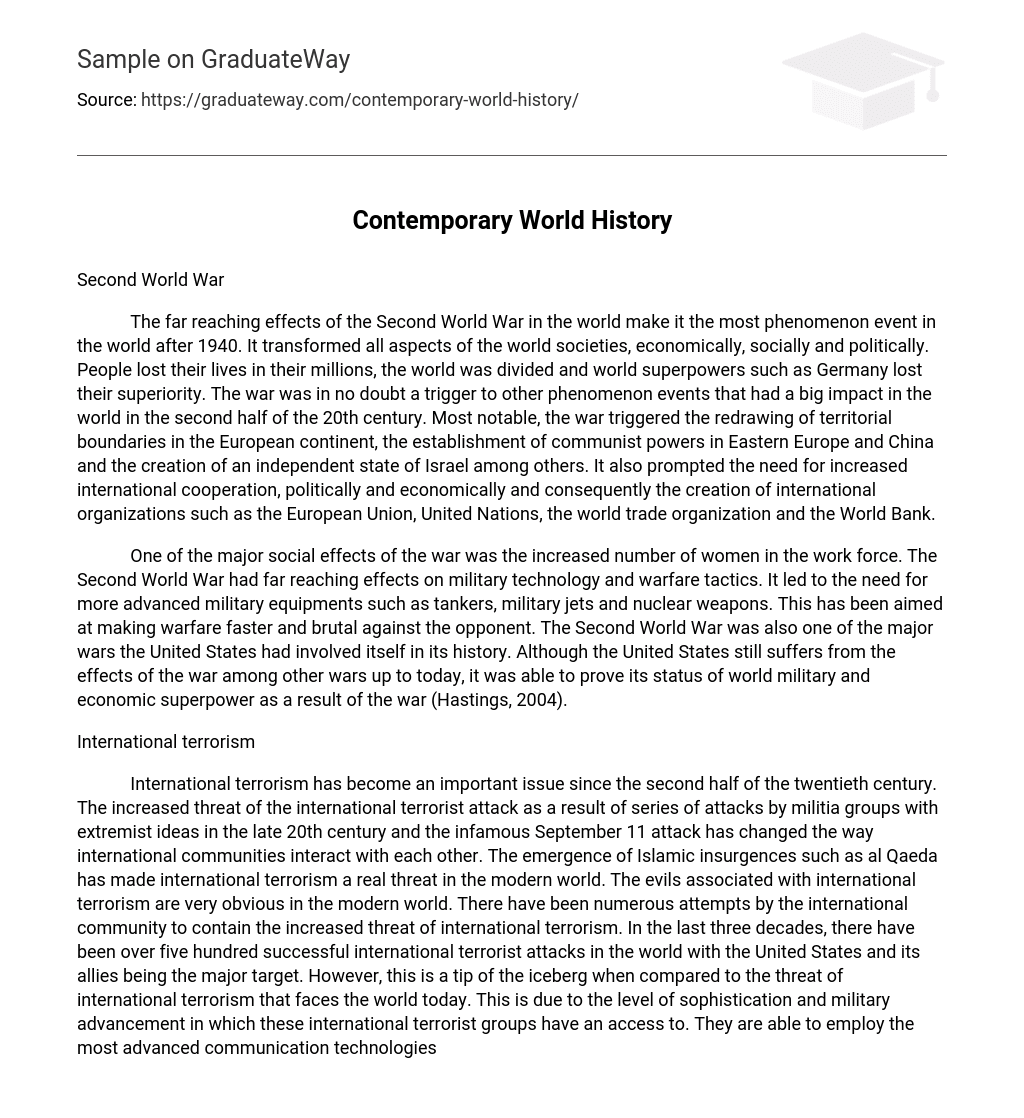Second World War
The far reaching effects of the Second World War in the world make it the most phenomenon event in the world after 1940. It transformed all aspects of the world societies, economically, socially and politically. People lost their lives in their millions, the world was divided and world superpowers such as Germany lost their superiority. The war was in no doubt a trigger to other phenomenon events that had a big impact in the world in the second half of the 20th century. Most notable, the war triggered the redrawing of territorial boundaries in the European continent, the establishment of communist powers in Eastern Europe and China and the creation of an independent state of Israel among others. It also prompted the need for increased international cooperation, politically and economically and consequently the creation of international organizations such as the European Union, United Nations, the world trade organization and the World Bank.
One of the major social effects of the war was the increased number of women in the work force. The Second World War had far reaching effects on military technology and warfare tactics. It led to the need for more advanced military equipments such as tankers, military jets and nuclear weapons. This has been aimed at making warfare faster and brutal against the opponent. The Second World War was also one of the major wars the United States had involved itself in its history. Although the United States still suffers from the effects of the war among other wars up to today, it was able to prove its status of world military and economic superpower as a result of the war (Hastings, 2004).
International terrorism
International terrorism has become an important issue since the second half of the twentieth century. The increased threat of the international terrorist attack as a result of series of attacks by militia groups with extremist ideas in the late 20th century and the infamous September 11 attack has changed the way international communities interact with each other. The emergence of Islamic insurgences such as al Qaeda has made international terrorism a real threat in the modern world. The evils associated with international terrorism are very obvious in the modern world. There have been numerous attempts by the international community to contain the increased threat of international terrorism. In the last three decades, there have been over five hundred successful international terrorist attacks in the world with the United States and its allies being the major target. However, this is a tip of the iceberg when compared to the threat of international terrorism that faces the world today. This is due to the level of sophistication and military advancement in which these international terrorist groups have an access to. They are able to employ the most advanced communication technologies to plan and execute their attacks and have access to advanced nuclear and biological weapons (Bird et al, 2008).
Despite all attempts by the international community to combat international terrorisms, an atmosphere of fear created by terrorist attacks threat is evidence in all parts of the world. However, the big question the international communities need to answer today is whether it is possible to develop programs that will deal with international terrorism. It is possible for international community to effectively deal with the threat of international terrorism. This is because these crimes are perpetuated by criminal groups that have limited abilities compared to the international community. To deal with these terror groups, it is important for the international community to take the most appropriate steps towards ending international terrorism. This calls for international cooperation between governments, security agencies and international organizations such as the United Nations and NATO. By every nation approaching the problem of international terrorism independently, the international terrorist groups are given an advantage.
Civil activism
Civil activism and civil movement that emerged after the Second World War are among the things that have transformed the world society since 1940s. The questions of the white supremacy and dominance in the American social affairs became major issues which progressively led to the civil rights era. A group of African American civil rights activists launched an attack against the Jim Crow laws that segregated and discriminated the people of color. Later, the African Americas were joined by other minority societies to fight for their rights and share in the American dream. Moreover, civil activists and students in American colleges protested against the role America was playing in the international affairs especially the Vietnam War.
The restiveness of the minority societies especially the African Americans increased in the 1960s which transformed the position of people of color in the American society and the world at large. The events of the civil rights era changed the structures and cultures of the American society by eliminating formal discrimination against minority races. However, racial discrimination is still evident in different parts of the world including the United States but there is no doubt that racial intolerance and prejudice has decreased significantly since 1960s. It is also important to note that other civil rights movements around the world pushing for rights of same sex marriages, women rights and the rights of disabled are organized in reference to the success of civil rights movements in the 1960s (Isserman & Michael, 2007).
Reference
Bird, G., S. Brock B. & Gregory D. H. (2008). “International Terrorism: Causes, Consequences and Cures.” World Economy. 31, 2 (02): pp 255-274
Hastings, M. (2004). The Second World War: A World in Flames, Osceola, WI: Osprey Publishing
Isserman, M. & Michael K. (2007). America Divided: The Civil War of the 1960s. New York, NY: Oxford University Press





